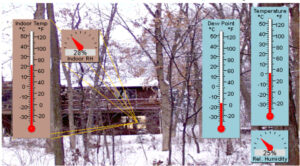The amount of moisture in the air, which is the humidity, is a very important aspect of weather.
There are a few ways to express the amount of water vapor in the atmosphere. Each way has advantages and disadvantages. Two of the more common are the dew point and the relative humidity.
The dew point is the temperature to which air must be cooled to become saturated with water vapor, assuming constant air pressure and water content. Dew forms when air is cooled to the dew point temperature.

The relative humidity is a percentage, defined as the ratio of the actual amount of water vapor in the air to the maximum amount of water vapor the air can hold. The maximum amount is a function of temperature. When the dew point temperature equals the air temperature, the relative humidity is 100% and the air is considered saturated with water vapor. The larger the difference between the dew point and the temperature, the lower the relative humidity. Cold outside air entering your home is heated by your furnace; this increases the temperature but not the dew point. This leads to a drop in relative humidity in your house, as the difference between the dew point temperature and the temperature in your home increases. If you want to explore this relationship between the thermostat setting in your house and the outdoor temperature and dew point, try this on-line activity at go.madison.com/dewpoint.
When the dew point is too low, your skin may dry out and feel itchy. Also, static electricity in your home may increase. This can cause clothes to stick together and for you to feel shocks when you touch something. Humidifiers add water molecules to the air, which increases the dew point temperature. That can result in a higher relative humidity.
Steve Ackerman and Jonathan Martin, professors in the UW-Madison department of atmospheric and oceanic sciences, are guests on WHA radio (970 AM) at 11:45 a.m. the last Monday of each month. Send them your questions at stevea@ssec.wisc.edu or jemarti1@wisc.edu.

